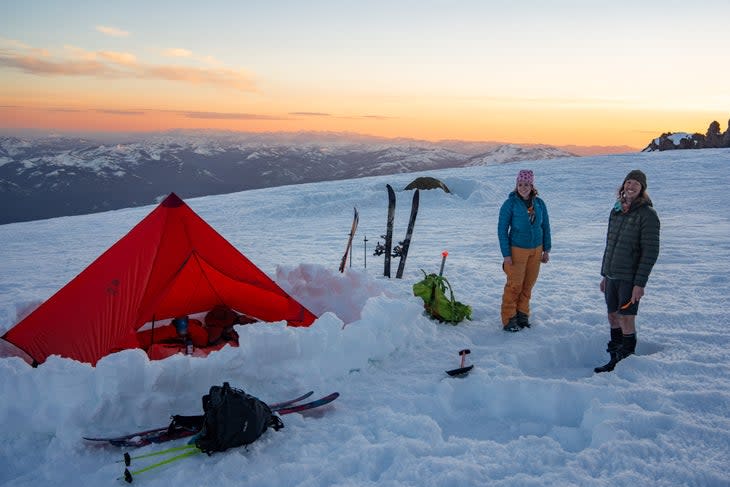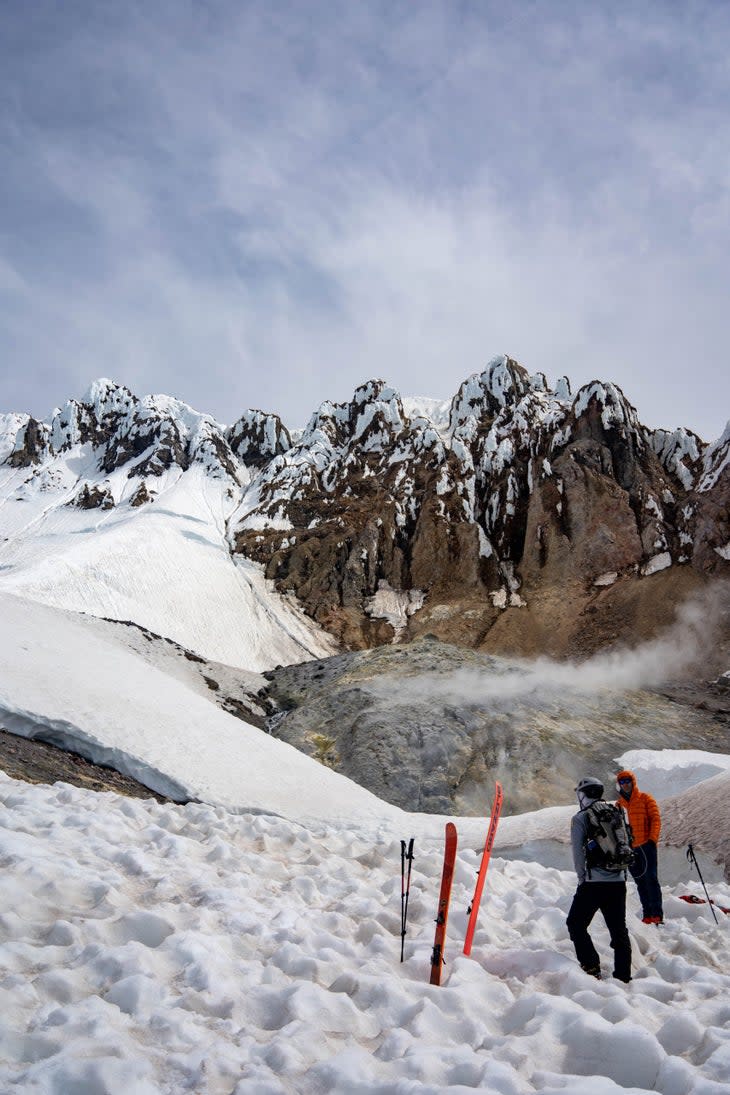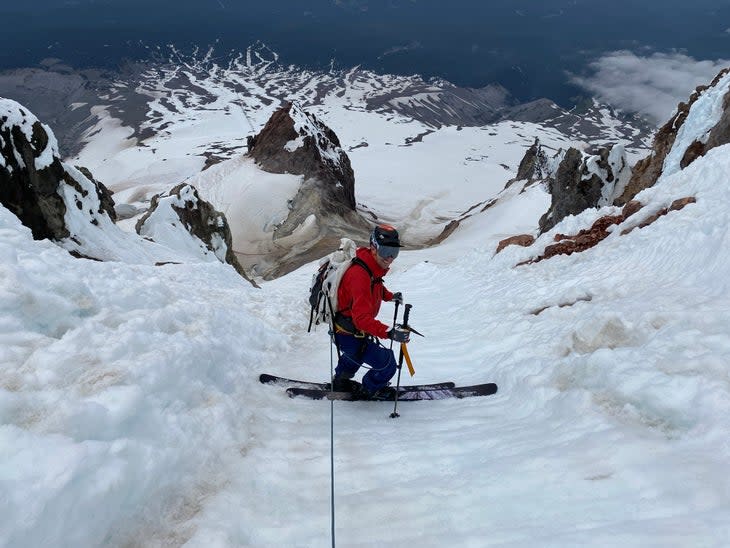Here’s Why You’re Never Too Experienced to Hire a Ski Guide
This article originally appeared on Ski Mag
The upslope winds refused to let the snow in Mount Shasta's Trinity Chutes soften, but it was after noon so our party of three decided to drop in anyway. We hacked short hop turns for the first 500 feet, and then began to open it up as the snow transitioned to corn.
My girlfriend Rita, our buddy Will, and I were feeling cautious because of the general circus we'd witnessed climbing California's northernmost fourteener. It seemed as if the entire city of San Francisco swarmed the mountain. We saw a splitboarder with no crampons climbing solo up toward the Red Banks; later, on Misery Hill, we noticed only half of the board was still attached to his pack while the other was lost to the ether.

We saw water bottles launched down glissade paths and people stumble and almost take the ride all the way down toward Lake Helen. The one thing we never saw was a single guided party. But the worst was yet to come.
As I arced larger and faster turns in the sun-softened corn back down toward the lake, I could barely make out Rita's muffled screams from above me. She was yelling "ROCK!"
I slammed a hockey stop and a piece of volcanic tuff the size of a microwave whizzed over my ski tips at chest height. The party above in the Trinity Chutes had toppled it to check the softness of the snow.
Feeling lucky to be alive, we pinned it back to the car. I've never skied 7,000 feet of vert faster than on that day.
Gear Up: The Best Backcountry Skis of 2023
Mountains are dynamic environments. Rocks become unglued as ice melts; rapid changes in temperature can create the conditions for wet avalanches. But many backcountry skiers seem to think that spring means safety, and everything is game on. Shasta's Avalanche Gulch is a 50 Classic North American Ski Descents inclusion and has relatively mellow descent options, but we saw skiers who'd never skied beyond a blue run in their life fumbling to put on crampons.
One thought resounded in my mind in the weeks that followed our ski descent: why don't Americans hire guides? I've worked as a climbing guide in the past and I would regularly come to the aid of parties who had taken their equipment straight from the gear shop to the crag and gave an adventure sport the ol' college try. I know it stems from our uniquely American exceptionalism and individualism--but it scares the hell out of me in practice.
Mount Hood had long been on my ticklist, so I decided to walk the walk and hire the best guide I could find. I drove up to Oregon and found myself at the Cooper Spur Mountain Resort just as the sun was setting on Oregon's highest peak.

I drove to Timberline Lodge bright and early the next morning to meet my IFMGA guide, Brian Campbell. That certification, what's known as a full-pin mountain guide, is the result of decades of skill development and client work in the rock, ski, and alpine disciplines. Only around 150 mountain guides in the U.S. have achieved their IFMGA pin. Campbell greeted me and, after a brief equipment check, he and I started to make a plan.
That Friday in June was beautiful--there was a superficial refreeze that kept the snow in decent shape and we would have light winds all day. The next day, however, would be socked-in and miserable. Normally day one would consist of skills clinics and instruction before a summit attempt on day two, but under these circumstances Campbell assessed my resume and suggested that we instead make a summit push on the first day.
Figuring we would have to stick to an institutional program, I was thrilled to learn that guides are quick to size up their clients and pivot to what would provide the best experience. He and I rode up to the top of the Palmer snow field and began skinning out toward the Hogsback.
In the Know: Pros Reveal the Most Unexpected and Trusted Gear in their Backcountry Packs
As we climbed toward the giant fumarole that steams below the Pearly Gates, I asked Campbell about what kind of trouble he sees unguided parties get into in the backcountry. He replied that while he rarely sees catastrophe, he sees near misses all the time. Campbell calls it "getting away with it."
Getting away with it sometimes provides learning opportunities, but it's an unsustainable way to travel in the mountains. "When your odds of coming home alive are 90 percent and you ski 10 days a season in the backcountry, those odds are unacceptable." If skiing in the backcountry is your passion, and especially if it's your livelihood, you have to build in more ample margins.
As we climbed up the Old Chute, a 45-degree pitch that leads to the summit ridge, Campbell decided to short rope me. He knew it was likely overkill, but we were traveling above open crevasses, in no-fall territory.
More skiers should travel with a rope in their pack, Campbell told me. It opens all kinds of possibilities that can build up your margins: you can approach cornices, dig pits at the top of your line, and ski cut all while on belay. You can rappel through crux sections and travel in glaciated terrain.
After we tagged the summit and took in the view of the seven different stratovolcanoes visible from the top of Mount Hood, we reversed our progress toward the top of the Old Chute. Campbell built an anchor and belayed me down a bulletproof sidestep almost exactly a ski-length wide that was exposed on both sides. When I got to the top of the Old Chute, I untied and made careful hop turns above the open crevasses. Once safe, we pinned it over to the West Crater Rim and skied an even steeper but much less exposed face back to the Palmer.

The weather arrived the next morning just as the National Weather Service promised, so Campbell ran me through a full crevasse rescue curriculum. We built haul systems and I learned to prep the crevasse lip to properly evacuate a victim out of the glacier's gaping maw. Because of my climbing experience, we were able to breeze through the basics and get into patient care and tricks to make the systems faster and more efficient.
I asked Campbell what he thinks intermediate and expert skiers are missing by going solo, and he told me that people are generally bad at assessing subjective hazards like their party's pace and skill level. They often don't have enough data and experience to make proper choices in the backcountry. They don't know what they don't know and that can land them in trouble. Guides excel at taking in the whole picture and explaining their decision-making processes.
Experts seem to think that guides will harsh their vibe and tone down the adventure of their trip, but in my experience, I've skied some of the steepest and rowdiest backcountry snow of my life with a Timberline Mountain Guide. He made that day possible with his knowledge of the terrain and conditions, and took me where I'd have the best chance at success skiing gnarly terrain. You're never too good to hire a guide; it's just that simple.
For exclusive access to all of our fitness, gear, adventure, and travel stories, plus discounts on trips, events, and gear, sign up for Outside+ today.

